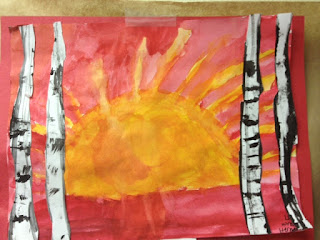One of the autumn art lessons is featured in the school's main entry. This collection was created by the third graders at
Coral Academy of Science. Let me walk you through our lesson:
We started by exploring basic painting technique using coffee. Yes, coffee! Instant coffee to be more precise. This gave the students an opportunity to get aquainted with using the brush and how to apply paint for
value--the lightness and darkness of a color. When in a pinch at home, a teaspoon of instant goes a long way. They can also experience the art element of
texture with the grounds as well. Already brewed coffee grounds work too but harder to get the variety in tones.
Birch Tree Steps
Analyze birch tree photos as a class.
On white A4 (standard 8x11.5) paper the students used black tempera paint to brush the outline of a birch tree.
Using a small piece of card stock, the students created the lines of the birch bark by dabbing along the tree shape. The larger areas of black were created by pulling the card stock piece, dipped in tempera, across the tree like a squeegee. Use quick flick movements to create that pull across the tree.
Set aside to dry. The students will cut these out and glue to a painted background.
Background
Discuss the warm and cool colors of the color wheel.
Students picked either warm or cool colors for their backgrounds. Using watercolors, they could paint any scene or pattern they wished, knowing it would be the background for their trees. Students are only given the primary colors of red, blue, and yellow. All the secondary colors (orange, green, purple) must be made by mixing. Once completed the trees were glued on and "frames" (colored onstruction paper) were selected. The students chose the color they felt would best compliment or enhance their paintings.
Critique
Once a project is complete, the students have an art walk. They walk the room admiring the other students' work, no talking, like a real gallery or museum space. A numbered popcicle stick is chose, that student gets to select his/her two favorites and explain to the class why they were drawn to that particular piece. I do allow students to choose their own as I believe it is important to be proud of one's work and be able to speak about it to others.
Language Arts Extension
Many poets have been inspired by the beauty of birch trees including Robert Frost. For our class, we read the following poem:
BERYOZA (The Birch tree)Poet – Sergei Yesenin ( ?- I am having trouble validating if this poem is indeed a Yesenin or not. I found it online with no credit but a mention to Yesenin)
The white birch below
My window stays
Covered by snow,
As with a golden blaze.
Snowflakes are gliding,
In the grip of air held,
Sun on them is shining,
Sparkling as on gold.
A birch tree stays lazy
In the morning air,
Its snow cover blazing
Like golden fire.
Again comes the blizzard,
And moving around,
Like a hoary wizard
Drops gold on the ground. 1913.
The students added poetry to their own art pieces:
By Laura
As the sunset is bright
just before the night
I go out and make a wish
as the sunset is bright
just before the night
I go inside and get inside my bed
As I go insdie and get inside my bed
As I keep that wish inside my head
Blue Night Sky by Izabella
Beautiful as a singing bird.
Lovely like a lover bird.
Unusable birch trees stand here for us to live.
Every birch tree stands for a piece of
love.
Neat and so special, nothing is prettier than a birch tree.
In the night sk with a smile on my face, I stand at a nice birch.
Grateful for you birch trees for being here.
Happy living in a lovely forest.
These birch trees help us live without them.
We wouldn't be here now.
Birch Tree Study
3rd Grade
Our exhibition shares our art exploration of:
v COLOR THEORY
· Warm & cool colors
v Media
· Cutting
o Scissors
· Gluing
o Glue sticks
o Liquid Glue
· painting
o watercolors
o tempera
o brushes
o card stock
v Observation
· Visually analyzing photographs of birch trees for Art Elements;
o Shape
o Color
o Form
o Texture
o Lines
o size
v Discussion
· Composition
· abstract Art
· realism
v Art Criticism
· students acted as critics and chose peer work for display
· explained their aesthetic choice

![creat[ed]](http://1.bp.blogspot.com/-cxRZQKhUfig/U8xKvtBIs2I/AAAAAAAAE9w/s-IxpjkUhpo/s1600/blogger-created-banner.jpg)

















































